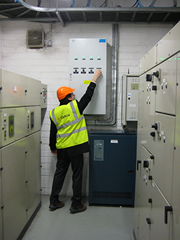Demand Side Management vs. Energy Efficiency: David and Goliath?

 For electricity consumers, demand side management is the new, and largely unknown kid on the block. Up until now, some consumers (mostly large ones) participated in the Winter Peak Demand Reduction Scheme (WPDRS) – a scheme that was introduced a decade ago when electricity capacity margins were tight, however that scheme has just closed. It had offered demand reduction at predetermined peak times (weekdays 5-7), and at times of the year when capacity margins traditionally shrunk (winter). With much larger current capacity margins of 2GW following a sharp demand destruction since the economic crash of 2008/2009, WPDRS no longer made sense. However, by engaging electricity consumers it paved the way for the introduction of a new more flexible demand response.
For electricity consumers, demand side management is the new, and largely unknown kid on the block. Up until now, some consumers (mostly large ones) participated in the Winter Peak Demand Reduction Scheme (WPDRS) – a scheme that was introduced a decade ago when electricity capacity margins were tight, however that scheme has just closed. It had offered demand reduction at predetermined peak times (weekdays 5-7), and at times of the year when capacity margins traditionally shrunk (winter). With much larger current capacity margins of 2GW following a sharp demand destruction since the economic crash of 2008/2009, WPDRS no longer made sense. However, by engaging electricity consumers it paved the way for the introduction of a new more flexible demand response.
Apart from the capacity margin excess, the inflexible nature of WPDRS didn’t match up to the market needs. As wind penetration grows beyond its current 15% of overall demand, flexibility has become the new watchword as the real market need becomes the peak gap between wind and demand, not peak demand itself. The WPDRS replacement’s official name is a Demand Side Unit (DSU), an example of which is Dalkia’s Virtual Power Plant (VPP) solution, which offers all those benefits to the system.
By offering up aggregated capacity from multiple sites of load shedding, emergency diesel generators or combined heat and power units at any time, a more flexible role from the consumer side can be achieved.
However VPPs are only part of the demand side management story. Another component is smart metering. Between now and 2019, every household and every business which doesn’t already have so, will have a smart meter installed at a total cost of €1 billion. Another future component, identified in CER’s 2011 Demand Side Vision for 2020, is real time pricing – which, if combined with automation, should provide the right pricing signals to enable consumer response to overall system needs.
But just how much impact will demand side management have? Ireland’s 2010 smart metering customer behaviour trials, which were conducted using a less flexible and less complicated (for the consumer that is) fixed time of day tariff incentivisation, achieved an overall electricity reduction of 2.5% and a peak reduction of 8.8% – useful but hardly a game changer. Meanwhile the VPP market in Europe is set to grow from 900MW in 2013 to 6.5GW by 2020, which compared to the current installed EU27 capacity of nearly 900GW is a drop in the ocean.
Enter our well known, but oft overlooked neighbour, energy efficiency. At a European level, it has been so overlooked that in October 2012, the EU adopted the energy efficiency directive to bridge the gap between a projected 10% energy efficiency saving if all currently identified measures are implemented, and a 20% savings target by 2020. The savings potential from energy efficiency are huge – the International Energy Agency “450 Scenario”, a 2009 study which looked at future actions to limit greenhouse gas atmospheric concentration to 450 parts per million, puts energy efficiency as the single most important contributor delivering over 50%.
Energy efficiency has already delivered huge benefits to Irish energy consumers. Since 1990, the energy intensity of the Irish economy (of which energy efficiency is a major driver), decreased by 46% up to 2011. So while demand side management will contribute to the overall goal of a low carbon economy, it is clear that for the moment it will remain the David, while energy efficiency delivers its Goliath performance.
Author: Mark Coyne, Dalkia Technical Director
For more information, visit www.dalkia.ie or email info@dalkia.ie





